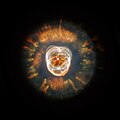Файл:Ngc2392.jpg
Облик

Размер на този преглед: 600 × 600 пиксела. Други разделителни способности: 240 × 240 пиксела | 480 × 480 пиксела | 768 × 768 пиксела | 1024 × 1024 пиксела | 1500 × 1500 пиксела.
Оригинален файл (1500 × 1500 пиксела, големина на файла: 1,16 МБ, MIME-тип: image/jpeg)
История на файла
Избирането на дата/час ще покаже как е изглеждал файлът към онзи момент.
| Дата/Час | Миникартинка | Размер | Потребител | Коментар | |
|---|---|---|---|---|---|
| текуща | 12:34, 28 юли 2005 |  | 1500 × 1500 (1,16 МБ) | Startaq | |
| 17:20, 1 февруари 2005 |  | 320 × 259 (12 КБ) | CWitte | Eskimo nebula |
Използване на файла
Следната страница използва следния файл:
Глобално използване на файл
Този файл се използва от следните други уикита:
- Употреба в af.wikipedia.org
- Употреба в ar.wikipedia.org
- Употреба в arz.wikipedia.org
- Употреба в ast.wikipedia.org
- Употреба в az.wikipedia.org
- Употреба в be.wikipedia.org
- Употреба в bn.wikipedia.org
- Употреба в bs.wikipedia.org
- Употреба в ca.wikipedia.org
- Употреба в ce.wikipedia.org
- Употреба в cs.wikipedia.org
- Употреба в cv.wikipedia.org
- Употреба в da.wikipedia.org
- Употреба в de.wikipedia.org
- Употреба в diq.wikipedia.org
- Употреба в el.wikipedia.org
- Употреба в en.wikipedia.org
- Planetary nebula
- Compact object
- Eskimo Nebula
- List of planetary nebulae
- User:Anticipation of a New Lover's Arrival, The/Galleries/Awards
- Caldwell catalogue
- Herschel 400 Catalogue
- User:Reginhild
- Wikipedia:Featured picture candidates/May-2007
- Wikipedia:Featured picture candidates/Eskimo Nebula
- User:Reginhild/Userboxes/Space Scientist
- Gemini (constellation)
- User:Sunfishtommy/sandbox
Преглед на глобалната употреба на файла.

